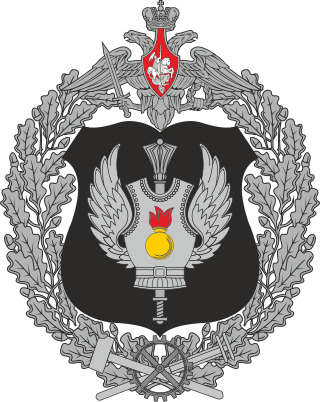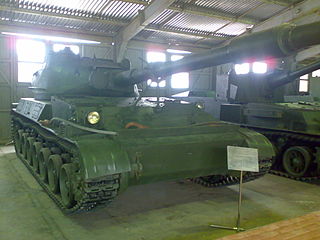
The Kliment Voroshilov (KV) tanks are a series of Soviet heavy tanks named after the Soviet defence commissar and politician Kliment Voroshilov who operated with the Red Army during World War II. The KV tanks were known for their heavy armour protection during the early stages of the war, especially during the first year of the German invasion of the Soviet Union. In certain situations, even a single KV-1 or KV-2 supported by infantry could halt German formations. The German Wehrmacht at that time rarely deployed its tanks against KVs, as their own armament was too poor to deal with the "Russischer Koloss" – "Russian Colossus".

The T-28 was a Soviet multi-turreted medium tank. The prototype was completed in 1931, and production began in late 1932. It was an infantry support tank intended to break through fortified defences. The T-28 was designed to complement the heavier T-35, with which it shared turret designs. The type did not have great success in combat, but it played an important role as a development project for Soviet tank designers. A series of new ideas and solutions that were tried out on the T-28 were later incorporated in future models.

The T-35B was a Soviet multi-turreted heavy tank of the interwar period and early Second World War that saw limited and service with the Red Army. Often called a land battleship, it was the only five-turreted heavy tank in the world to reach production, but proved to be slow and mechanically unreliable. Most of the T-35B tanks still operational at the time of Operation Barbarossa were lost due to mechanical failure rather than enemy action. It was designed to complement the contemporary T-28 medium tank; however, very few were built.

The SU-85 was a Soviet self-propelled gun used during World War II, based on the chassis of the T-34 medium tank. Earlier Soviet self-propelled guns were meant to serve as either assault guns, such as the SU-122, or as tank destroyers; the SU-85 fell into the latter category. The designation "85" means the bore of the vehicle's armament, the 85 mm D-5T gun.

The SU-152 is a Soviet self-propelled heavy howitzer used during World War II.

The ISU-122 was a Soviet assault gun used during World War II, mostly in the anti-tank role.

The 152 mm howitzer-gun M1937 (ML-20), is a Soviet heavy gun-howitzer. The gun was developed by the design bureau of the plant no 172, headed by F. F. Petrov, as a deep upgrade of the 152-mm gun M1910/34, in turn based on the 152-mm siege gun M1910, a pre-World War I design by Schneider. It was in production from 1937 to 1946. The ML-20 saw action in World War II, mainly as a corps / army level artillery piece of the Soviet Army. Captured guns were employed by Wehrmacht and the Finnish Army. Post World War II, the ML-20 saw combat in numerous conflicts during the mid to late twentieth century.

The BA-10 was an armored car developed in the Soviet Union in 1938 and produced through 1941. It was the most produced Soviet pre-1941 heavy armored car – 3311 were built in three versions. These versions were the BA-10, the BA-10M, and the BA-10ZhD. The basic BA-10 design was developed from the BA-3 and BA-6 heavy armored cars. It had an improved GAZ-AAA chassis and improved armor. It was intended that the BA-10 would be replaced in 1941 by the BA-11 with diesel engine and more sophisticated armor design, but the outbreak of war prevented BA-11 production. The BA-10 was in Red Army service until 1945. Significant numbers of captured BA-10s were used by Finland, Germany and other Axis powers in Europe.

The D-1 howitzer M1943 is a Soviet World War II-era 152.4 mm howitzer. The gun was developed by the design bureau headed by F. F. Petrov in 1942 and 1943, based on the carriage of the 122 mm howitzer M1938 (M-30) and using the barrel of the 152 mm howitzer M1938 (M-10). The powerful and mobile D-1, with its wide range of ammunition, significantly increased the firepower and breakthrough abilities of Red Army tank and motor rifle formations. Several hundred D-1s were manufactured before the end of World War II.
A tank corps was a type of Soviet armoured formation used during World War II.

The KV-13 was an experimental Soviet medium tank created during World War II. It was developed on the KV-1 chassis in the SKB-2 design bureau of the Chelyabinsk Kirov Plant in late 1941 – early 1942, as a "universal" tank, intended to replace the production of T-34 medium tanks and KV-1 heavy tanks at the same time.

The Main Automotive-Armoured Directorate of the Ministry of Defence of the Russian Federation is a department of the Russian Ministry of Defence which is subordinated to the Chief of Armaments and Munitions of the Armed Forces, vice-minister of defense.
The Southern Group of Forces (YUGV) was a Soviet Armed Forces formation formed twice following the Second World War, most notably around the time of the Hungarian Revolution of 1956.

Garford-Putilov armoured cars were an armoured fighting vehicle produced in Russia during the First World War era. They were built on the chassis of Garford Motor Truck Co. lorries imported from the United States.

The Object 120 SU-152 "Taran" was a fully enclosed Soviet tank destroyer built in 1965, which never progressed past the experimental stage.
Hovercraft tank, or, officially, the amphibious hovering tank was developed at Moscow aircraft plant #84 in the USSR in 1937 by a group of engineers led by professor Vladimir Israilevich Levkov. Its development never left the mockup stage.

The T-10 was a Soviet heavy tank of the Cold War, the final development of the IS tank series. During development, it was called Object 730. It was accepted into production in 1953 as the IS-8, but due to the political climate in the wake of Stalin's death in 1953, it was renamed T-10.

The U-5TS tank gun is a 115 mm-calibre weapon that was fitted exclusively to the Soviet Union's T-62 main battle tank. It was the first smoothbore weapon designed for tanks and heralded the change in main armament from rifled cannons.

The SU-100P is a Soviet experimental 100-mm self-propelled howitzer, and is designed by OKB-3 of the heavy machine construction division of Uralmash. The main designer of the SU-100P is Lev Gorlitsky. The SU-100P was intended to suppress and destroy enemy firing positions, engage enemy armored vehicles, as well as area denial, in addition to conducting counter-battery tasks. It was intended to be the main competitor of the Object 416.
















